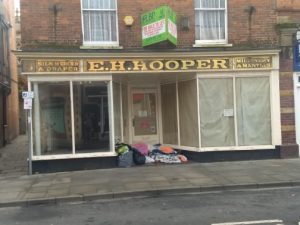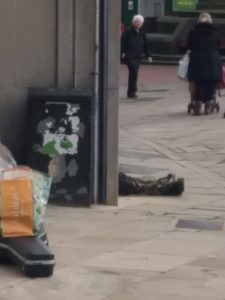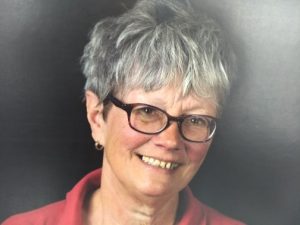
There was a general election just before Christmas. Everybody will have forgotten about it by now. The result was predicted and the outcome was clear. Yet during that election British people must have walked past literally 1,000s of people sleeping rough on the streets of their towns and cities and thought ‘Fair enough that’. Those on the left who argued that it was Tory austerity to blame were doubted or maybe people thought it wasn’t a problem and that they were alright (Jack). Either way the problem is still here and someone has to deal with it. On the streets of Bridgwater there’s been a spike in the number of rough sleepers – up from a nightly average of 3-5 to a new height of 13-15. So, what’s that all about and what are we doing about it?

Bridgwater Town Council has no powers in respect of homelessness but with an office on the High Street it is often the first port of call for people asking ‘What is to be done?’ Bridgwater Town Councillors, being the closest to the people, are acutely aware of the rise in rough sleepers in the town centre and the issue is often conflated with ASB complaints which are either brought to Council meetings where the Police are always in attendance, or face the mixed anger and compassion on the social media sites. Town Council Deputy Leader Cllr Kathy Pearce (Labour, Westover), agreed to set up a Multi-Agency Forum to gauge the scale of the problem and to make sure support was in place. Kathy’s Forum, turned out to be the first time that these agencies, including the Police, Social Services, Westfield Church, Sedgemoor Housing and others had been brought together in one place. This meeting happened in the early autumn of 2019 and in January 2020 Cllr Pearce chaired a follow up Sedgemoor Scrutiny meeting which included an updated review of the progress.
The Frontline Response
The key person in all this turned out to be Sedgemoor Housing Advice Manager Sarah Stillwell, who is on the frontline, and who explained to both the Forum and the Committee what was happening, what was being done about it and what more had still to be done.

Outlining the scale of the problem in Sedgemoor, Sarah said there were currently 10 families and 16 singles in temporary accommodation but that Rough Sleeping had increased substantially to a figure round about 13-15 daily. “Sedgemoor is working with the other local authorities across Somerset on a homelessness strategy to take them through to 2023. Our priorities include bringing empty properties across the county back into use. There are, in fact, approximately 2,000 across the county. There was also a widening ‘affordability gap’ and so there was a need to influence housing providers to deliver suitable accommodation that is both affordable and meets local needs There was a need for more temporary accommodation to meet the needs of clients, including specialist arrangements such as for disabled people.”
Some authorities had taken different approaches to rough sleeping with Mendip and Taunton Deane taking advantage of the Governments new funding which has caused some of the recent displacement..
Sarah continued “One problem was that the direct access hostel in Taunton, Lindley House, which could be previously accessed by SDC now could no longer be used due to changes in policy by Taunton Deane which made this option limited. Sedgemoor consequently faced an increase in rough sleepers crossing the district borders and now they had to be dealt with locally where direct access provision was historically non-existent. Sedgemoor Referrals to Lindley House had always accounted for some 30% of the population there. Faced with this increase locally, SDC then chose to work closely with Westfield Church, where volunteers provide hot meals and a laundry service twice a week for rough sleepers.”
What is on offer
Sarah explains “Funding from both Sedgemoor and Bridgwater Town Council increased to Westfield church including joined up service support such as DWP presence to assist with benefit claims, SDAS assessments to assist with substance abuse, a Citizens Advice ‘Complex Adults Worker’ attending, housing adviser and ARC outreach workers to give housing advice, Health Link workers to give health advice.”

“SDC officers undertook a ‘spotlight count’ to gauge the actual number of rough sleepers. This information has helped us put in a SDC bid to MHCLG for additional funding and as part of this bid a key new property at Blake House in Bridgwater, owned and managed by YMCA, will come into use as a SSTS (somewhere safe to stay) Hub.”
“The development of Blake House is the most crucial intervention by SDC in the rough sleeping problem as it means that sleepers can be engaged with and the start of a pathway to support and enablement can be established. This has to be a holistic approach and tailored to the individual as there is no one size to fit all. Blake Place will be developed as a SSTS Hub where rough sleepers can be assessed and their needs identified. This can also help with establishing a ‘no first night out’ property for people who are in danger of becoming the next generation of rough sleepers”
Sarah turned to the problem of engaging with rough sleepers, which she admitted often took an average of 50 contacts before getting a response. “Historically there has been a problem of non-engagement, due likely to feelings of hopelessness and failure between rough sleepers and the authorities during previous attempts. However, the Homelessness Reduction Act which came into operation in 2018 places a duty on the LA to work with clients for 56 days before they can progress to a full decision and SDC staff are able to develop a PHP – (Personal Housing Plan).”
It is clear that Local Authorities need to support both prevention policies as well as intervention and recovery programmes and Sarah says that SDCs service aim was to ‘secure, support and sustain’. “I have restructured the service to provide the Officers with technical administration to monitor Personal Housing Plans and ensure regular contact is kept with those clients threatened with homelessness. The new roles enable a route for staff succession so at SDC we are in effect growing our own Housing Solution Officers of the future. I want greater emphasis on tenancy sustainment, as a service I want to educate and empower our customers to be able to manage their homes and finances to enable them to remain in their properties whenever possible. Any moves should be planned, avoiding the use of temporary accommodation whenever possible. As part of the restructure we are looking at improving our services within the Private Sector to offer customers more choice this also enables us to offer solutions beyond Homefinder Somerset.”
The Street Link Initiative

Sarah Stillwell pointed to the website for Street Link https://www.streetlink.org.uk/. Reports of rough sleeping are sent through directly to the local authority for a callout within 24 hours from one of Sarah’s team.
Sarah Stillwell and her team are fire fighting and time will show if they will gain the upper hand in that battle. Kathy Pearce and her Multi-Agency Forum are getting a clearer picture of the scale of that struggle. Kath says “Rough Sleeping is on the rise and has been for some time .In 2018 the National figure was 4,677, which showed an increase of 156% since 2010. In 2019 in London there were an average 1,283 rough sleepers a night and 148 deaths attributed to homelessness. However, the real figures are likely to be very different. A survey by homeless charity Shelter says the Rough Sleeper figures are closer to 24,000 with some 9,000 of these in London. Shelter also identified the wider ‘homeless’ figure as nearer 300,000 2017, 320,000 in 2018 . The reported number of homeless people dying on the streets has more than doubled in 5 years.”
Begging and ASB -a Community Response needed
Associated with rough sleeping is begging. Often seen as ‘aggressive begging’. At a recent Bridgwater Town Council meeting where a Police report is always the first item, the subject was raised.
Town Clerk David Mears said that “22 businesses over the Christmas period contacted us with examples of persistent and intrusive instances of begging. Staff, customers and the public have a right not to be harassed. The implication is that there is an active group of already housed beggars.”

The Police spokesperson accepted that there was an issue of a number of people presenting themselves as homeless who in fact were adequately housed and who engaged in opportunistic begging adding “Begging is illegal under the Vagrancy Act of 1824. However, it does not aically carry a jail sentence. Police in Sedgemoor tackle it as ASB through the issue of CPN (Community Protection Notices) and it is clearly not acceptable if people are being harassed while going about their normal business.”
Cllr Glen Burrows (Labour, Eastover) was concerned about an over-reaction saying “There is a wall of hysteria around this and often an intolerant attitude. The answer is a community response not putting more people in prison. There’s plenty of abominable people out there in suits and ties as well and who live in nice houses. There’s another dialogue that needs to be had to counter the prejudice and hysteria.”
So, there’s rough sleeping, homelessness and temporary homelessness. There are 71,000 sofa surfers across the UK. People in temporary accommodation, usually BnBs, numbers 68,000 ‘households’ in 2018 and jumped to 86,000 in 2019 -a rise of 4.5%.

Town Council Leader Brian Smedley (Labour, Westover) said “All political parties say they are aware of the problem and they are committed to ending it – yet the figures keep rising, which suggests those in power are simply not doing enough. I think that’s also because their policies of austerity have caused this in the first place. They say they will end homelessness by 2024 but at this rate there could be 10,000 more people sleeping on the streets by then ‘unless there is a cultural shift in the way the problem is understood’. The Government needs to take homelessness much more seriously. In its narrowest sense, homelessness – as in literally having no roof over one’s head – could be ended almost overnight. The Labour Party is putting forward active solutions and in a recent speech by Kier Starmer he suggested that people who are sleeping rough should be offered the money they need to find somewhere to live, to keep themselves clothed and fed, and to begin rebuilding their lives. We could do this by offering rough sleepers a personal budget, just as we already do for people assessed as having a social-care need. In fact, many people living rough or in shelters already have such needs, whether this is down to poor health, a disability, alcohol or drug problems, or being in an abusive relationship. If the prime minister really does believe in people ‘taking control’ of their lives, he should give rough sleepers the opportunity to do so. The causes of homelessness are also avoidable. An undersupply of housing and stagnating living standards have caused rents and prices to spiral out of reach for many. An underfunded and mismanaged welfare system has failed to act as an effective safety net for those at risk of losing their homes. And mental-health services are unable to cope with the demands put upon them. Ultimately, homelessness is a product of the everyday instability that derives from the Government’s failure to tackle the UK’s structural economic problems and the drift to the right means that all of this is taking place in a less compassionate ‘self help’, ‘I’m alright Boris’ environment. And that has to change.”

Why isn’t st Mary’s Church involved? Especially for severe weather emergency. They have (new) underfloor heating.